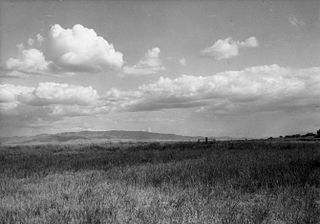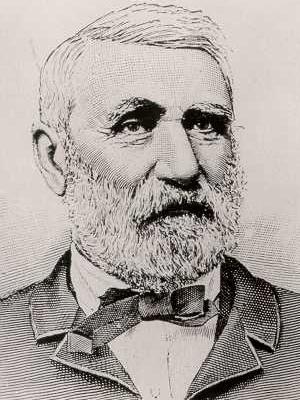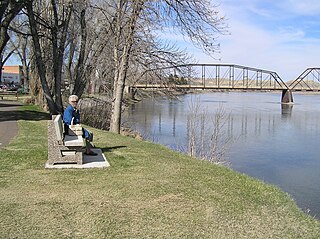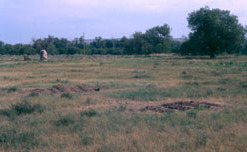
Fort Benton is a city in and the county seat of Chouteau County, Montana, United States. Established in 1846, Fort Benton is the oldest continuously occupied settlement in Montana. Fort Benton was the most upstream navigable port on the Mississippi River System, and is considered "the world’s innermost port".

Fort Pierre is a city in Stanley County, South Dakota, United States. It is part of the Pierre, South Dakota micropolitan area and the county seat of Stanley County. The population was 2,115 at the 2020 census.

Manuel Lisa, also known as Manuel de Lisa, was a Spanish citizen and later, became an American citizen who, while living on the western frontier, became a land owner, merchant, fur trader, United States Indian agent, and explorer. Lisa was among the founders, in St. Louis, of the Missouri Fur Company, an early fur trading company. Manuel Lisa gained respect through his trading among Native American tribes of the upper Missouri River region, such as the Teton Sioux, Omaha and Ponca.

Fort Hall was a fort in the Western United States that was built in 1834 as a fur trading post by Nathaniel Jarvis Wyeth. It was located on the Snake River in the eastern Oregon Country, now part of present-day Bannock County in southeastern Idaho. Wyeth was an inventor and businessman from Boston, Massachusetts, who also founded a post at Fort William, in present-day Portland, Oregon, as part of a plan for a new trading and fisheries company. In 1837, unable to compete with the powerful British Hudson's Bay Company, based at Fort Vancouver, Wyeth sold both posts to it. Great Britain and the United States both operated in the Oregon Country in these years.

The American Fur Company (AFC) was founded in 1808, by John Jacob Astor, a German immigrant to the United States. During the 18th century, furs had become a major commodity in Europe, and North America became a major supplier. Several British companies, most notably the North West Company and the Hudson's Bay Company, were eventual competitors against Astor and capitalized on the lucrative trade in furs. Astor capitalized on anti-British sentiments and his commercial strategies to become one of the first trusts in American business and a major competitor to the British commercial dominance in North American fur trade. Expanding into many former British fur-trapping regions and trade routes, the company grew to monopolize the fur trade in the United States by 1830, and became one of the largest and wealthiest businesses in the country.

Fort Union Trading Post National Historic Site is a partial reconstruction of the most important fur trading post on the upper Missouri River from 1829 to 1867. The fort site is about two miles from the confluence of the Missouri River and its tributary, the Yellowstone River, on the Dakota side of the North Dakota/Montana border, 25 miles from Williston, North Dakota.
Fort Kiowa, officially Fort Lookout and also called Fort Brazeau/Brasseaux, was a 19th-century fur trading post located on the Missouri River between modern Chamberlain, South Dakota, and the Big Bend of the Missouri.
Chouteau was the name of a highly successful, ethnically French fur-trading family based in Saint Louis, Missouri, which they helped found. Their ancestors Chouteau and Laclède initially settled in New Orleans. They then moved-up the Mississippi river and established posts in the Midwest and Western United States, particularly along the Missouri River and in the Southwest. Various locations were named after this family.

Fort Osage was an early 19th-century factory trading post run by the United States Government in western Missouri on the American frontier; it was located in present-day Sibley, Missouri. The Treaty of Fort Clark, signed with certain members of the Osage Nation in 1808, called for the United States to establish Fort Osage as a trading post and to protect the Osage from tribal enemies.

Kenneth McKenzie was nicknamed the "King of the Missouri", for as a fur trader for American Fur Company in the upper Missouri River valley, he controlled a territory larger than most European nations.

Jean-Pierre Chouteau was a French Creole fur trader, merchant, politician, and slaveholder. An early settler of St. Louis from New Orleans, he became one of its most prominent citizens. He and his family were prominent in establishing the fur trade in the city, which became the early source of its wealth.

Pierre Chouteau Jr., also referred to as Pierre Cadet Chouteau, was an American merchant and a member of the wealthy Chouteau fur-trading family of Saint Louis, Missouri.

Theophile Bruguier was a French-Canadian fur trader with the American Fur Company. Bruguier is credited as being the first white settler of what would become Sioux City, Iowa.

The history of South Dakota describes the history of the U.S. state of South Dakota over the course of several millennia, from its first inhabitants to the recent issues facing the state.
Fort Berthold was the name of two successive forts on the upper Missouri River in present-day central-northwest North Dakota. Both were initially established as fur trading posts. The second was adapted as a post for the U.S. Army. After the Army left the area, having subdued Native Americans, the fort was used by the US as the Indian Agency for the regional Arikara, Hidatsa, and Mandan Affiliated Tribes and their reservation.
The Missouri Fur Company was one of the earliest fur trading companies in St. Louis, Missouri. Dissolved and reorganized several times, it operated under various names from 1809 until its final dissolution in 1830. It was created by a group of fur traders and merchants from St. Louis and Kaskaskia, Illinois, including Manuel Lisa and members of the Chouteau family. Its expeditions explored the upper Missouri River and traded with a variety of Native American tribes, and it acted as the prototype for fur trading companies along the Missouri River until the 1820s.
This timeline of South Dakota is a list of events in the history of South Dakota by year.

The Fort Benton Historic District is a National Historic Landmark District encompassing the historic waterfront areas of Fort Benton, Montana. Founded as a fur trading post at the head of navigation of the Missouri River, it was prior the advent of the railroad one of the nation's largest inland ports, playing a pivotal role in the development of the American and Canadian West. The Front Street and waterfront area of the city preserves elements of this history. It was designated a National Historic Landmark in 1961, although its boundaries were not formally determined until 2012.
Columbia Fur Company was a fur trading and Indian trading business active from 1821 to 1827, in Michigan Territory and in the unorganized territory of the United States. It then became the Upper Missouri Outfit of the American Fur Company.
Henry Fraeb, also called Frapp, was a mountain man, fur trader, and trade post operator of the American West, operating in the present-day states of Colorado, Wyoming, and Montana.


















